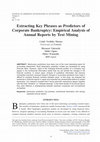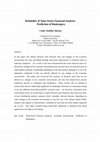Papers by Shirata Cindy Yoshiko
Finance Association. The data collection assistance of Madhurima Bhutkar and Sunny Khan is apprec... more Finance Association. The data collection assistance of Madhurima Bhutkar and Sunny Khan is appreciated. 1 Banking Crisis and Mergers – The Case of Japan In contexts where banks have strong control over firms, banking crisis may be associated with merger activity. This is because banks ’ risk is reduced when their clients merge, and financial trouble creates strong incentive for banks to facilitate mergers of clients to improve banks ’ risk standing. During Japan’s banking crisis in the 1990s, corporate merger activity was correlated with banks ’ financial trouble. Banks of merger firms were unhealthy, and on average gained positive abnormal returns upon announcements of mergers between their clients. Wealth gain to banks partially stemmed from acquirer pre-merger slack, which could be used postmerger to redeem bank loans to the total merged firms. (JEL G21, G34, N25)

This study is aimed to review and to provide critical review to the methods of assessing the fina... more This study is aimed to review and to provide critical review to the methods of assessing the financial condition of local government (LG). Research assessing the financial conditions of LG is relatively new. As a result, there is little agreement about what appropriate methods, procedures, dimensions, and indicators to assess the financial condition of LG. To review the methods, this study utilise the criteria of a good measure (i.e. reliability, validity, and practicality) as a benchmark. The methods reviewed are compared with the criteria. The critical review will identify the strengths and limitations of the methods. The results show that there is no model that satisfies all the attributes of a good measure. Several common weaknesses of the previous methods are involving too many variables; assuming that all dimensions and indicators of the financial condition have equal importance; utilizing non-financial indicator instead of ' financial indicators to assess the financial co...
Springer eBooks, 2000
We presents some empirical results of a study regarding financial ratios as predictors of Japanes... more We presents some empirical results of a study regarding financial ratios as predictors of Japanese corporate bankruptcy based on a large sample of bankrupt and non-bankrupt firms' financial data. In this study, variable as predictors of bankruptcy had been selected by three Al-based data mining techniques and two conventional statistical methods, Logit analysis and Stepwise. After the selection of a set of variables for every method, discriminant power of each set was compared to verify the most suitable data mining technique to select financial variables. Finally, the study concludes that a set of variables selected by Logit analysis (with logit model) indicated the best discriminant power, more than 87% accuracy.
The study presents some empirical results of a study regarding financial ratios as predictors of ... more The study presents some empirical results of a study regarding financial ratios as predictors of Japanese corporate bankruptcy based on a large sample of bankrupt and non-bankrupt firms' financial data. In this study, variables as predictors of bankruptcy were selected by two data mining techniques: CART and Stepwise. After the selection of a set of variables for the two techniques,

Journal of Emerging Technologies in Accounting, Dec 1, 2011
Bankruptcy predictions have been one of the most interesting topics for accounting researchers. M... more Bankruptcy predictions have been one of the most interesting topics for accounting researchers. Most bankruptcy prediction models are developed by using financial ratios. However, signs of the changing financial position of a company may appear in the nonfinancial information earlier than we can identify the changes in the financial numbers. In recent years, analysis of qualitative information has become remarkably important, because frequent changes in accounting standards have made it difficult to compare financial numbers between years. In this study, we analyzed the sentences in financial reports in Japan and extracted key phrases/descriptions to predict bankruptcy. Our research revealed that if some particular expressions appear together with the word ''dividend'' or ''retained earnings'' in the same section of an annual report, they were effective in distinguishing between bankrupt companies and non-bankrupt companies.
The Journal of Business Analysis
The Journal of Business Analysis
The Journal of Business Analysis
The Journal of Business Analysis

In this paper, the relation between each financial ratio and changes in the economic environment ... more In this paper, the relation between each financial ratio and changes in the economic environment has been elucidated through time-series observations of financial ratios in bankrupt companies. As a result, it has been demonstrated that some financial ratios are affected by changes in the economic environment and also that there are financial ratios in which figures fluctuate considerably depending on the time period, although it is yet to be adequately confirmed if they are directly affected by any change in the economic environment. This paper also uncovered the existence of financial ratios that are not affected by changes in the economic environment and also that distinctively present tendencies specific to companies near bankruptcy. Some criticize that an attempt to extract ratios that are statistically significant for bankruptcy detection in a univariate setting is not any different from Beaver[1967]'s research work. As, however, researchers have concentrated much on constr...
KES'2000. Fourth International Conference on Knowledge-Based Intelligent Engineering Systems and Allied Technologies. Proceedings (Cat. No.00TH8516)
The study presents some empirical results of a study regarding financial ratios as predictors of ... more The study presents some empirical results of a study regarding financial ratios as predictors of Japanese corporate bankruptcy based on a large sample of bankrupt and non-bankrupt firms' financial data. In this study, variables as predictors of bankruptcy were selected by two data mining techniques: CART and Stepwise. After the selection of a set of variables for the two techniques,

The Japanese economy is on a clear recovery path. Average share prices showed a gradual uptrend s... more The Japanese economy is on a clear recovery path. Average share prices showed a gradual uptrend since September 2005, reaching 17,000 yen ($155 USD) in March 2007 before falling back in recent months; Bank of Japan's quantitative easing policy, an economic stimulus program introduced in March 2001, has been dismantled; and land prices in certain commercial areas of central Tokyo have seen a sharp rise. One factor behind the country's economic recovery has been the disposal of nonperforming loans and the establishment of a system enabling corporate rehabilitation. This was achieved through such measures as the Resolution and Collection Corporation (RCC) (April 1999), the Civil Rehabilitation Law (April 2000), and the Industrial Revitalization Corporation of Japan (April 2003). Numerous new businesses have now emerged from "rehabilitation." The author analyzed the vast financial data of companies that have undergone "civil rehabilitation" to shed light on w...

This paper reports an importance of disclosure of contingency information/hidden risks from the p... more This paper reports an importance of disclosure of contingency information/hidden risks from the point of view of the corporate governance. This paper also introduces a nuclear accident at a uranium-processing plant run by JCO Co., a subsidiary of Sumitomo Metal Mining Co., Ltd. as a case study. This paper pointed out that a parent company never disclosed any risk information on their public financial statements even though their subsidiary had been in a hazard or peril to cause the nation's worst-ever nuclear accident. However the company tries to disclose risks, it is limited because managers do not have enough skills to recognize the existence of risks. The importance is not only the attitude for disclosure but also the knowledge and positive thinking to face their own risks. Some of other Asian Pacific countries that are resource-poor and need to build an independent source of energy in the form of nuclear power, has been facing a similar difficult situation. When we think ab...
This paper reports some empirical results of an analysis regarding prediction of Japanese corpora... more This paper reports some empirical results of an analysis regarding prediction of Japanese corporate failure, evidenced by bankruptcy. Several empirical studies of corporate failure in Japan have been undertaken in the past. However, the results of these studies are not generalizable, due to the limited size of their samples. In contrast, this study proposes a generalizable bankruptcy prediction model based on observations of 686 Japanese firms that went bankrupt, and 300 Japanese non-bankrupt firms that were extracted from 107,034 non-bankrupt firms by a systematic sampling method. The model proposed in this study is a universal model which is independent of industry and size. The study proves that the model can predict Japanese corporate bankruptcy with more than 86% accuracy regardless of industry and size.

The Japanese economy is on a clear recovery path. Share prices have shown a gradual uptrend since... more The Japanese economy is on a clear recovery path. Share prices have shown a gradual uptrend since September 2005, reaching 17,000 Yen in March 2007: BoJ’s quantitative easing policy, which was introduced on 19 March 2001, has been dismantled; and land prices in certain commercial areas of central Tokyo have seen a sharp rise. One factor behind this economic recovery has been the disposal of non-performing loans and the establishment of a social system enabling corporate rehabilitation. This was achieved through such measures as the establishment of Resolution and Collection Corporation (RCC) in April 1999, the enforcement of the Civil Rehabilitation Law in April 2000, and the establishment of the Industrial Revitalization Corporation of Japan in April 2003. Numerous new businesses have now emerged under the banner of “rehabilitation.” However, corporate rehabilitation has been limited to a select number of companies.











Uploads
Papers by Shirata Cindy Yoshiko